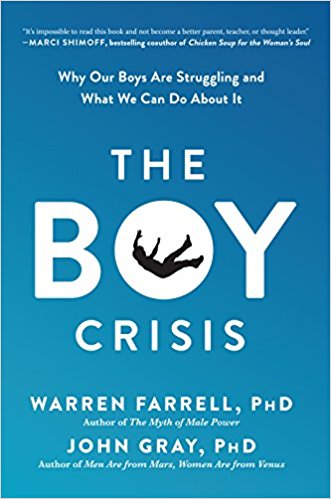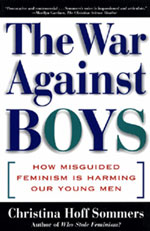![]()
One of Canada's two national
newspapers
Male-bashing could prove 'disastrous,' authors warn
New book on misandry
National Post, Graeme Hamilton, November 14, 2001
MONTREAL - Men feeling down on themselves need look no further than their local greeting-card shop or video-rental store for an explanation, the Montreal authors of a controversial new book argue.
In Spreading Misandry: The Teaching of Contempt for Men in Popular Culture, McGill University professor Katherine Young and co-author Paul Nathanson warn that male-bashing is so pervasive in movies, television, comic strips and even greeting cards, it could have "disastrous consequences" for society.
Dr. Nathanson, who has been working with Dr. Young on the project for 15 years, said misandry -- the hatred of men -- is unexplored academic terrain.
"I don't even know how to pronounce it," he said during an interview yesterday. "I've never heard the word used." He said the U.S. Library of Congress has three books under the heading of misandry but thousands under misogyny -- the term for hatred of women.
The authors hope their book, published by McGill-Queen's University Press, will make the word a part of everyday vocabulary.
"Our hypothesis is that, like misogyny once upon a time, misandry has become so deeply embedded in our culture that few people -- including men -- even recognize it," they write.
Men who are offended are reluctant to take a stand because of "the taboo on male vulnerability," they write.
The examples of misandry cited cover a broad range. They refer to a greeting card that said, "Men are scum" on the outside and inside, "Excuse me. For a second there, I was feeling generous." They take issue with Blondie, Hagar the Horrible and Beetle Bailey, saying "pathetic men are de rigueur in comic strips."
The brunt of their attack, however, is reserved for television and movies, everything from Home Improvement and Beavis and Butt-Head to Sleeping with the Enemy and Silence of the Lambs. Men are laughed at, denigrated or demonized, receiving treatment that would never be acceptable if directed at women, they say.
Dr.Young, a professor of religious studies at McGill, said her research has attracted some hostility from "ideological feminists" who believe women are superior to men.
"As we wrote it, we realized it's going against the grain, and therefore it's going to be controversial," she said.
She added that being a tenured professor made it easier for her to take on the controversial topic without fear of harm to her career.
Some may be tempted to dismiss the book as another example of academics overly obsessed with popular culture. Its index is peppered with such entries as Buffy the Vampire Slayer, Gloria Gaynor, Murphy Brown, Sex and the City and The Vagina Monologues. One appendix, titled the Misandric Week on Television, analyzes a week of TV Guide listings for examples of dastardly men.
The book is the first of three volumes about misandry the pair will publish with McGill-Queen's. Dr. Young said the issue needs to be explored because it is exacting a social toll.
Fed a popular-culture diet of men who are either hapless or downright evil, boys and young men are feeling more alienated, she said. "What group wants to live with constant negative stereotyping?"
Even more serious is the gulf such portrayals create between the sexes. "What happens to society when the prevailing world view is dualistic, with one group seen as good and the other as evil?" she asked. In their book, the authors warn such polarization could provoke a backlash.
"If men are told over and over again that they are not only brutal subhumans in general but also hostile to women in particular, they are likely to say, 'So be it ...' What goes around, according to the old saying, comes around," they write.
Copyright 2001 National Post Online
McGill-Queen's University Press
Read the preface and table of contents of Spreading Misandry.





